
Grand Duke Alexei Petrovich of Russia was a Russian Tsarevich. He was born in Moscow, the son of Tsar Peter I and his first wife, Eudoxia Lopukhina. Alexei despised his father and repeatedly thwarted Peter's plans to raise him as successor to the throne, to continue his policies. His brief defection to Austria scandalized the Russian government, leading to harsh reprisals against Alexei and his associates. Alexei died after interrogation under torture, and his younger half brother Peter Petrovich became the new heir apparent.
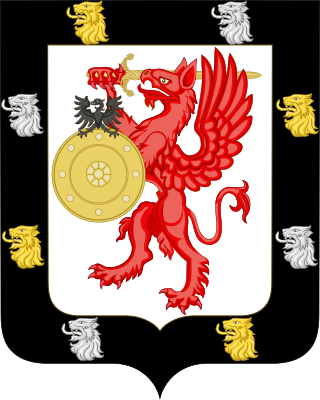
The House of Romanov was the reigning imperial house of Russia from 1613 to 1917. They achieved prominence after Anastasia Romanovna married Ivan the Terrible, the first crowned tsar of all Russia. Nicholas II and his immediate family were executed in 1918, but there are still living descendants.

Grand Duchess Tatiana Nikolaevna of Russia was the second daughter of Tsar Nicholas II, the last monarch of Russia, and of Tsarina Alexandra. She was born at Peterhof Palace, near Saint Petersburg.

Alexei Mikhailovich, also known as Alexis, was Tsar of all Russia from 1645 until his death in 1676.

Alexei Nikolaevich was the last Tsesarevich. He was the youngest child and only son of Emperor Nicholas II and Empress Alexandra Feodorovna. He was born with haemophilia, which his parents tried treating with the methods of a peasant faith healer named Grigori Rasputin.

Tsesarevich was the title of the heir apparent or presumptive in the Russian Empire. It either preceded or replaced the given name and patronymic.
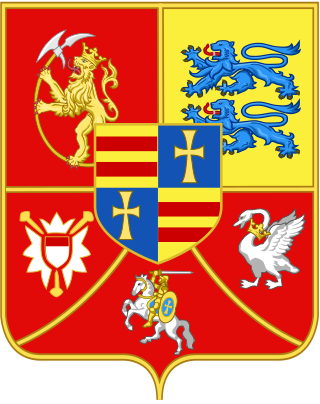
Holstein-Gottorp or Schleswig-Holstein-Gottorp is the historiographical name, as well as contemporary shorthand name, for the parts of the duchies of Schleswig and Holstein, also known as Ducal Holstein, that were ruled by the dukes of Schleswig-Holstein-Gottorp, a side branch of the elder Danish line of the House of Oldenburg. Other parts of the duchies were ruled by the kings of Denmark.
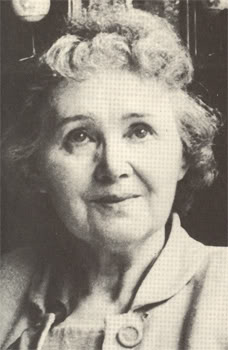
Eugenia Smith, also known as Eugenia Drabek Smetisko, was one of several Romanov impostors who claimed to be the Grand Duchess Anastasia, youngest daughter of Nicholas II, the last Tsar of Imperial Russia, and his wife Tsarina Alexandra.
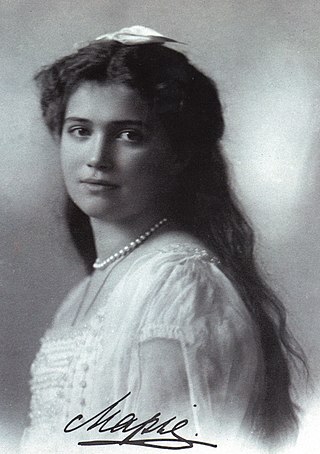
Grand Duchess Maria Nikolaevna of Russia was the third daughter of Tsar Nicholas II of Russia and Tsarina Alexandra Feodorovna. Her murder following the Russian Revolution of 1917 resulted in her canonization as a passion bearer by the Russian Orthodox Church.
Nicholas Romanovich Romanov was a claimant to the headship of the House of Romanov and president of the Romanov Family Association. Although undoubtedly a descendant of Tsar Nicholas I of Russia, his claimed titles and official membership in the former Imperial House were disputed by those who maintained that his parents' marriage violated the laws of the Russian Empire.

Ipatiev House was a merchant's house in Yekaterinburg where the former Emperor Nicholas II of Russia, his family, and members of his household were executed in July 1918 following the Bolshevik Revolution. Its name is identical to that of the Ipatiev Monastery in Kostroma, from where the Romanovs came to the throne. As an act for the 60th anniversary of the Russian Revolutions, it was demolished in 1977 by orders of the Politburo to the local soviet government, almost 59 years after the Romanov family murder and 14 years before the dissolution of the Soviet Union itself.
Alexei Tammet-Romanov was the name assumed by Ernest Veermann, an Estonian immigrant to Canada, when he claimed to be the last heir to the throne of Russia, Tsarevich Alexei Nikolaevich of Russia. For many years prior to this, Veerman had been known as Heino Tammet, a name he first used when in the printing business. A few of his postcards are extant.

Pierre Gilliard was a Swiss academic and author, best known as the French language tutor to the five children of Emperor Nicholas II of Russia from 1905 to 1918. In 1921, after the Russian Revolution of 1917, he published a memoir, Thirteen Years at the Russian Court, about his time with the family. In his memoirs, Gilliard described Tsarina Alexandra's torment over her son's hemophilia and her faith in the ability of starets Grigori Rasputin to heal the boy.

The canonization of the Romanovs was the elevation to sainthood of the last Imperial Family of Russia – Tsar Nicholas II, his wife Tsarina Alexandra, and their five children Olga, Tatiana, Maria, Anastasia, and Alexei – by the Russian Orthodox Church.
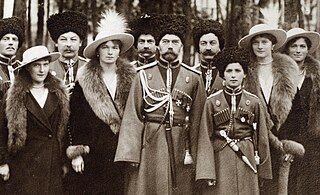
Members of the ruling Russian imperial family, the House of Romanov, were executed by a firing squad led by Yakov Yurovsky in Yekaterinburg, Russia, on July 17, 1918, during both the Russian Civil War and near the end of the First World War.

Michał Franciszek Goleniewski a.k.a. 'SNIPER', 'LAVINIA',, was a Polish officer in the People's Republic of Poland's Ministry of Public Security, the deputy head of military counterintelligence GZI WP, later head of the technical and scientific section of the Polish intelligence, and a spy for the Soviet government during the 1950s. In 1959, he became a "triple agent" by giving Polish and Soviet secrets to the Central Intelligence Agency that directly caused the exposure of George Blake and Harry Houghton. Goleniewski defected to the United States in 1961. He later made unsubstantiated claims to be Tsarevich Alexei Nikolaevich of Russia.

The Tsarevich egg, also known as the Czarevich egg, is a Fabergé egg, one of a series of jewelled eggs made under the supervision of Peter Carl Fabergé. It was created in 1912 for Empress Alexandra Fyodorovna as a tribute by Fabergé to her son the Tsarevich Alexei (Alexei). The egg is currently in the Virginia Museum of Fine Arts in Richmond, Virginia, US.

Prince George Alexandrovich Yuryevsky was the natural son of Alexander II of Russia by his mistress, Princess Catherine Dolgorukova. The morganatic marriage of George's parents on 6 July 1880, eight years after his birth, resulted in the legitimation of their three surviving children, and George gained the style of Serene Highness.

The Russian Imperial Romanov family were shot and bayoneted to death by Bolshevik revolutionaries under Yakov Yurovsky on the orders of the Ural Regional Soviet in Yekaterinburg on the night of 16–17 July 1918. Also murdered that night were members of the imperial entourage who had accompanied them: court physician Eugene Botkin; lady-in-waiting Anna Demidova; footman Alexei Trupp; and head cook Ivan Kharitonov. The bodies were taken to the Koptyaki forest, where they were stripped, mutilated with grenades to prevent identification, and buried.

Grand Duchess Olga Nikolaevna of Russia was the eldest child of the last Tsar of the Russian Empire, Emperor Nicholas II, and of Empress Alexandra of Russia.

















